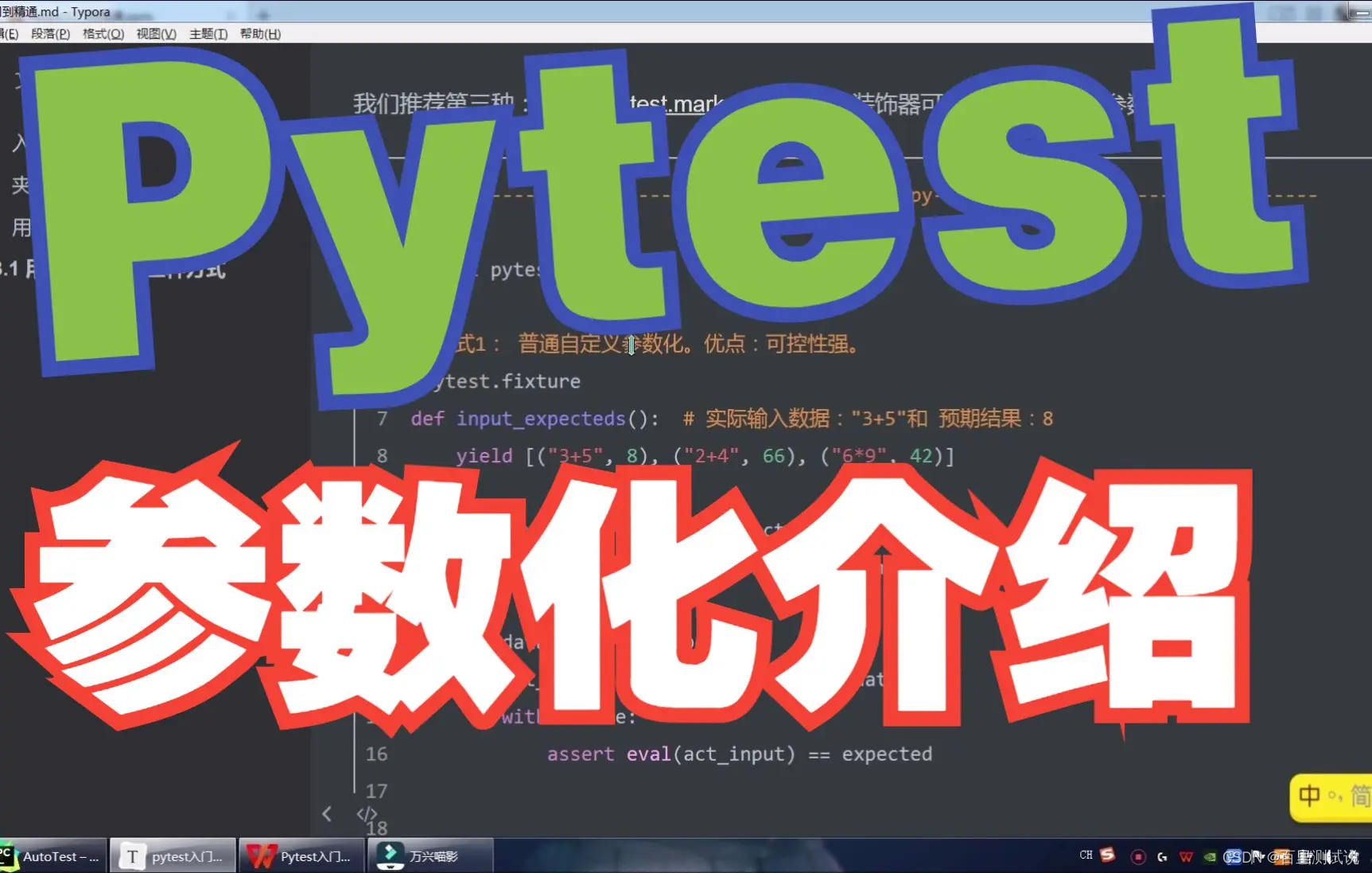前言
我们都知道pytest和unittest是兼容的,但是它也有不兼容的地方,比如ddt数据驱动,测试夹具fixtures(即setup、teardown)这些功能在pytest中都不能使用了,因为pytest已经不再继承unittest了。
不使用ddt数据驱动那pytest是如何实现参数化的呢?答案就是mark里自带的一个参数化标签。

一、源码解读
关键代码:@pytest.mark.parametrize
我们先看下源码:def parametrize(self,argnames, argvalues, indirect=False, ids=None, scope=None):,按住ctrl然后点击对应的函数名就可查看源码。
def parametrize(self,argnames, argvalues, indirect=False, ids=None, scope=None):
""" Add new invocations to the underlying test function using the list
of argvalues for the given argnames. Parametrization is performed
during the collection phase. If you need to setup expensive resources
see about setting indirect to do it rather at test setup time.
:arg argnames: a comma-separated string denoting one or more argument
names, or a list/tuple of argument strings.
:arg argvalues: The list of argvalues determines how often a
test is invoked with different argument values. If only one
argname was specified argvalues is a list of values. If N
argnames were specified, argvalues must be a list of N-tuples,
where each tuple-element specifies a value for its respective
argname.
:arg indirect: The list of argnames or boolean. A list of arguments'
names (self,subset of argnames). If True the list contains all names from
the argnames. Each argvalue corresponding to an argname in this list will
be passed as request.param to its respective argname fixture
function so that it can perform more expensive setups during the
setup phase of a test rather than at collection time.
:arg ids: list of string ids, or a callable.
If strings, each is corresponding to the argvalues so that they are
part of the test id. If None is given as id of specific test, the
automatically generated id for that argument will be used.
If callable, it should take one argument (self,a single argvalue) and return
a string or return None. If None, the automatically generated id for that
argument will be used.
If no ids are provided they will be generated automatically from
the argvalues.
:arg scope: if specified it denotes the scope of the parameters.
The scope is used for grouping tests by parameter instances.
It will also override any fixture-function defined scope, allowing
to set a dynamic scope using test context or configuration.
"""
我们来看下主要的四个参数:
参数1-argnames:一个或多个参数名,用逗号分隔的字符串,如"arg1,arg2,arg3",或参数字符串的列表/元组。需要注意的是,参数名需要与用例的入参一致。
参数2-argvalues:参数值,必须是列表类型;如果有多个参数,则用元组存放值,一个元组存放一组参数值,元组放在列表。(实际上元组包含列表、列表包含列表也是可以的,可以动手试一下)
# 只有一个参数username时,列表里都是这个参数的值:
@pytest.mark.parametrize("username", ["user1", "user2", "user3"])
# 有多个参数username、pwd,用元组存放参数值,一个元组对应一组参







 我们都知道pytest和unittest是兼容的,但是它也有不兼容的地方,比如ddt数据驱动,测试夹具fixtures(即setup、teardown)这些功能在pytest中都不能使用了,因为pytest已经不再继承unittest了。不使用ddt数据驱动那pytest是如何实现参数化的呢?答案就是mark里自带的一个参数化标签
我们都知道pytest和unittest是兼容的,但是它也有不兼容的地方,比如ddt数据驱动,测试夹具fixtures(即setup、teardown)这些功能在pytest中都不能使用了,因为pytest已经不再继承unittest了。不使用ddt数据驱动那pytest是如何实现参数化的呢?答案就是mark里自带的一个参数化标签
 最低0.47元/天 解锁文章
最低0.47元/天 解锁文章















 2681
2681











 被折叠的 条评论
为什么被折叠?
被折叠的 条评论
为什么被折叠?








